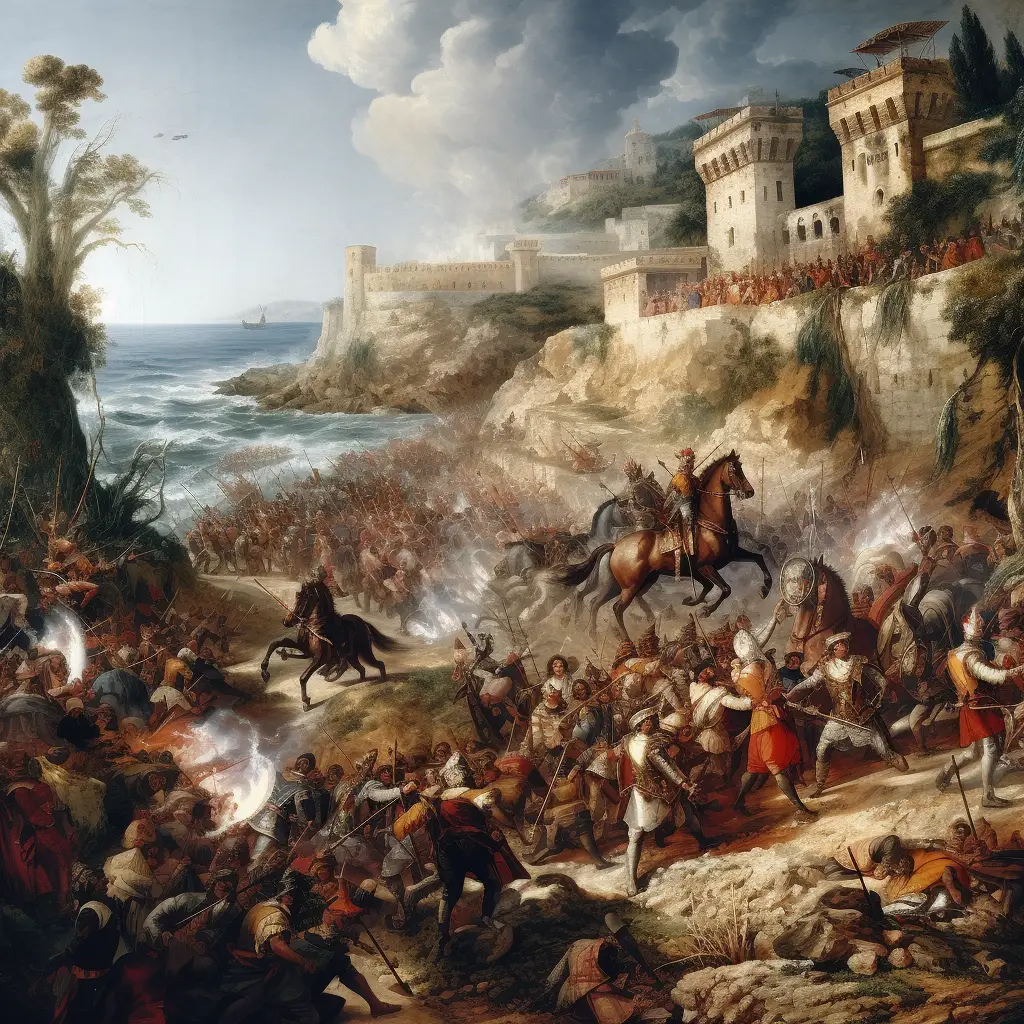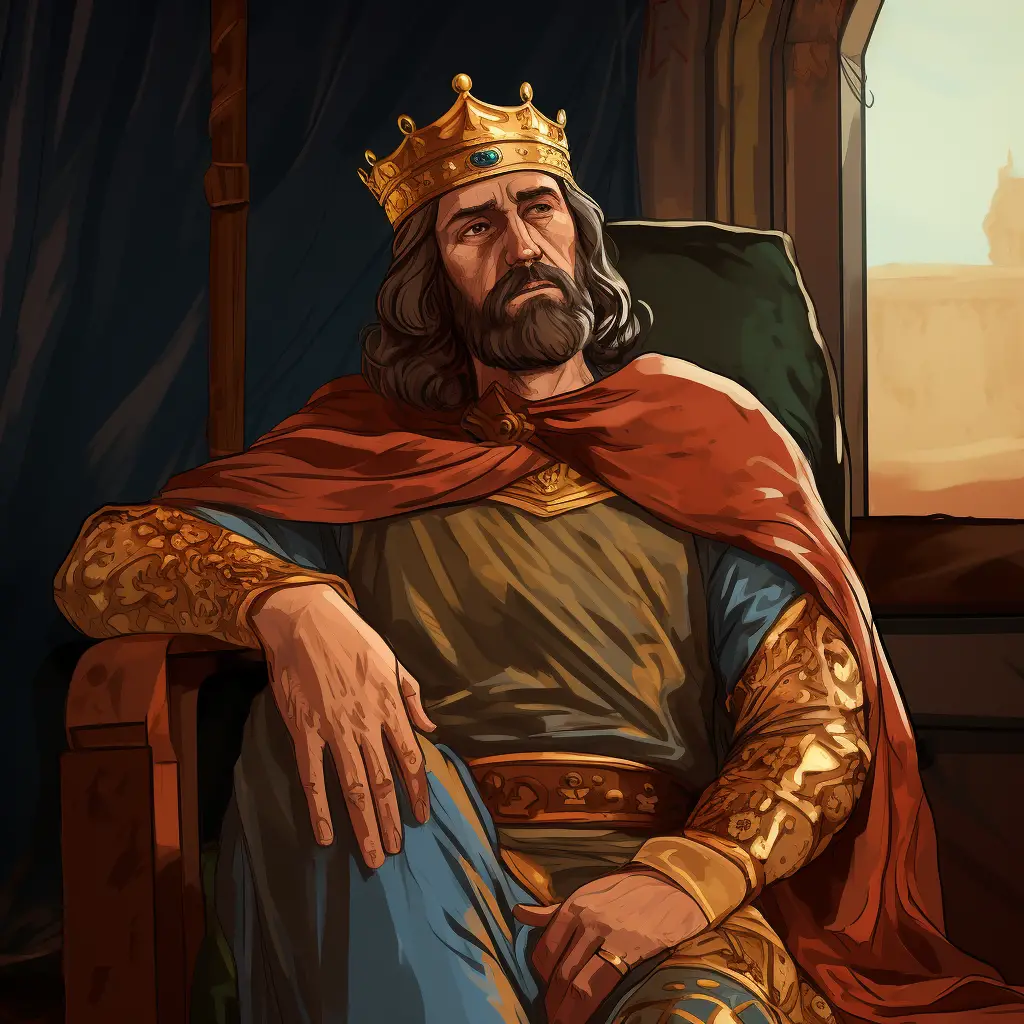Genseric
Genseric or Gaiseric was the King of Vandals. He reigned during the fifth century and was a major tormentor of the Western and Eastern Roman Empire. Genseric ruled for almost fifty years and transformed a small Germanic tribe into a powerful kingdom along the Mediterranean Sea.
He secured stunning victories against Roman legions and annexed territories of Sicily, Corsica, Carthage, Malta, and Numidia. His greatest feat was perhaps the invasion and plunder of Rome in 455. Unfortunately, Vandals could not survive long after Genseric’s death in 477 AD.
Genseric Facts for Kids
- Genseric was the King of the Vandals and Alans.
- He reigned from 428 AD to 477 AD.
- He turned the Vandals into a major power.
- Genseric led the Vandal sack of Rome in 455 AD.
- His kingdom included parts of Africa and the Mediterranean.
- He was known for his naval power.
- Genseric was an Arian Christian, a form of early Christianity.
- His capital was Carthage, a city in present-day Tunisia.
- He made treaties but often broke them.
- Genseric died in 477 AD, ruling for 49 years.
Vandals and Alans
Recognized as the King of the Vandals and Alans, Genseric significantly influenced the course of history from 428 to 477, steering a critical period of transition that reshaped the Mediterranean’s political and cultural landscape.
His leadership transformed the Vandals and Alans, originally Germanic and Iranian tribes, into a formidable force, far from their initial barbaric state. Genseric’s tactical skill in both land and naval warfare allowed his kingdom to grow, even threatening the powerful Roman Empire.
The apex of his reign was the successful sacking of Rome in 455, showcasing the might of his North African kingdom and firmly establishing his place in history.
Fall of the Western Roman Empire
Genseric, the influential King of the Vandals and Alans, was a pivotal figure in the collapse of the Western Roman Empire. His rule, which spanned from 428 to 477 AD, was characterized by the robust expansion of his dominion across North Africa and the Mediterranean.
His most significant accomplishment, the 455 AD sack of Rome, dealt a severe blow to the already faltering empire. The shift in power dynamics during this period can be attributed to Genseric’s robust naval power, strategic warfare, and ruthless treatment of his adversaries, factors that hastened the decline and eventual downfall of the Western Roman Empire. Thus, Genseric’s reign epitomized the power transition from the classical Roman Empire to the emerging Germanic kingdoms.
Sack of Rome (455 AD)
Genseric, the Vandal King, was a critical influence in the 455 AD Sack of Rome, the third of four total assaults on the city. His strategic expertise enabled the Vandals to infiltrate the ‘Eternal City’ successfully, distinguishing this event in Rome’s history.
Unlike typical barbaric destruction, Genseric meticulously planned and executed an orderly two-week plundering of Rome, strategically avoiding burning the city or slaughtering its residents to conserve its wealth and resources. The Vandals managed to loot massive quantities of treasure, including the Capitol’s golden roof tiles, which were subsequently transported to their North African capital.
Genseric’s significant role in the Sack of Rome served not only to magnify his standing as a formidable leader but also represented a crucial turning point in the Western Roman Empire’s decline.
Migration period (Barbarian invasions)
In the Migration Period, or Barbarian Invasions, Genseric, King of the Vandals and Alans, played a crucial role that lasted over four decades in the 5th century, a period marked by widespread migrations and territorial disputes.
Recognized for his military acumen and strategic vision, Genseric led his people from Spain into Roman North Africa, significantly influencing the political landscape of Western Europe. His capture of Carthage in 439 was his most significant victory, turning the Vandals into a formidable maritime force. His pivotal role during this period was instrumental in the decline of the Western Roman Empire.
Kingdom of the Vandals and Alans
Genseric, the celebrated king of the Vandals and Alans from 428 to 477, played a crucial role in reshaping the Western Roman Empire. His strategic acumen and military expertise led to the establishment of a potent Vandal kingdom in North Africa, turning it into a significant Mediterranean power.
His reign, marked by successful military campaigns, included the prominent capture of Carthage in 439, which then became his kingdom’s capital and a vital maritime trade center. Perhaps the most infamous of his conquests was the sacking of Rome in 455, which solidified the dominance of the Vandals and Alans in the region.
Genseric’s leadership ultimately transformed a band of tribal warriors into a formidable kingdom, leaving a lasting imprint on the history of North Africa and the Mediterranean.
North Africa in Late Antiquity
Genseric, an influential figure in North Africa during the Late Antiquity, reigned as the King of the Vandals and Alamanni from 428 to 477. He orchestrated a significant migration of Vandals and Alans across the icy Rhine in 406, instigating a considerable invasion of Roman Western Europe.
Genseric’s reign was marked by his triumphant establishment of a stable and independent Vandal kingdom in North Africa, specifically in the heart of the Roman province of Africa Proconsularis. His rule was characterized by relentless efforts to consolidate political control over the territories seized by the Vandals, accompanied by victorious military campaigns, the most significant of which was the sack of Rome in 455.
Through his leadership, Genseric profoundly influenced the geopolitical dynamics of North Africa during the Late Antiquity, turning the region into a Vandal stronghold and significantly altering the trajectory of Western and North African history.
Roman Emperor Valentinian III
As the King of the Vandals, Genseric played an instrumental role in the fall of Roman Emperor Valentinian III by capitalizing on the internal discord within the Roman Empire. His strategic invasion of North Africa in 439 AD, part of his ruthless tactics, resulted in the seizure of this prosperous province from Valentinian III.
This event, which marked the loss of a critical source of grain and wealth for the Roman Empire, greatly undermined Valentinian’s rule, accelerating the decline of the Western Roman Empire. Genseric’s actions thus positioned him as a formidable adversary of Rome and signified a considerable power shift from Rome to the Germanic tribes.
Battle of Cartagena (460)

Genseric, the formidable King of the Vandals and Alans, distinguished himself as one of the most feared leaders of his time through his pivotal role in the Battle of Cartagena in 460. His ruthless tactics and shrewd leadership led to the Vandals seizing control of Cartagena, transforming the city into a strategic base for their maritime operations in the Western Mediterranean.
Not only did this demonstrate Genseric’s military prowess, but it also underscored his strategic acumen in identifying the city’s significance for the expansion of his empire. The successful capture of Cartagena marked a significant turning point in the Vandals’ military campaign, showcasing Genseric’s relentless ambition and the ruthless efficiency with which he pursued his conquests.
Byzantine-Vandal wars
Genseric, reigning as the Vandal King during the Byzantine-Vandal wars, was a crucial figure in these historical disputes. He was infamous for his tactical military strategies and unyielding ambition, propelling the Vandals on their North African conquest and their victorious raid on Rome in 455 AD.
A relentless opponent to the Byzantine Empire, Genseric persistently tested its might and territorial dominion. His rule instigated a noteworthy shift in Mediterranean power structures, with the Vandals rising as a formidable adversary against the Byzantine Empire.
Despite the Vandals’ ultimate defeat and subsequent decline, Genseric’s influence on the Byzantine-Vandal wars continues to be a significant facet of this historical epoch.
Christian Arianism
Genseric, the king of the Vandals in the 5th century, played a notable role in propagating Christian Arianism, a significant variant of the faith that asserts Christ’s divinity but not his unity with God the Father. Despite his reputation as a barbarian conqueror, he was a fervent patron of Arian Christianity, a faith that he introduced to his traditionally pagan subjects.
His dedication to Arianism was so strong that he granted religious freedom to his subjects, although he did take over Catholic Churches, transforming them into Arian places of worship. Genseric’s reign not only reshaped the religious landscape of his kingdom but also left an enduring impact on the early history of Christianity.

Early Life
Genseric was born in 389 AD. He was an illegitimate son of Godigisel, King of Hasdingi Vandals. Hasdingi Vandals were the southern tribes of Vandals. He was born near Lake Balaton (Hungary). In 406, his father died during the Battle of Mainz against the Franks. After Godigisel’s death, Genseric’s elder half-brother Gunderic assumed the mantle.
Under his reign, Genseric became the second most influential man in the Kingdom after his brother. At that time his tribe lived in the Roman province of Hispania Baetica. During Gunderic’s rule, Vandals supported Alans in their struggle against Visigoths. In 428, Gunderic died and the Vandals elected Genseric as their new King.
Genseric’s Reign: Soon after taking over Genseric started thinking of strengthening his tribe and asserting his control. Vandals had fought several battles against Visigoths and the attrition of men and resources had taken its toll on the tribe’s wealth and population. Genseric decided to leave Baetica and move to Roman North Africa. According to historians, he had started building a fleet for this purpose even before he was crowned.
During their journey, the Vandals were attacked from the rear by a strong force of Suebi, another Germanic tribe and sworn enemies of the Vandals. However, Genseric’s army defeated Suebi near Merida, and their leader, Heremigarius drowned in the Guadiana River while trying to escape. Genseric managed to transport 80,000 of his people across the Mediterranean into Northern Africa in 429. It is contended by some historians that Genseric was invited by the Roman governor of Africa, Bonifacius to help him in his struggle against the imperial government.
However, in 430 Genseric turned against Bonifacius and earned several victories against the combined forces of Western and Eastern Roman Empires. He took control of Mauretania and a portion of Numidia. After a treaty in 435 with the Romans, he was recognized as the ruler of his invaded land but was made to pay tribute to the Romans and promise that he would not attack Carthage. In 439, he executed a surprising move and attacked and annexed Carthage. In 442, a treaty was signed with Romans which accepted Vandals as the masters of Pro-consular Africa.
Genseric’s fleet controlled much of the western Mediterranean and soon he took over the Balearic Islands, Corsica, Sicily, and Sardinia. His most audacious move was to invade and plunder Rome in 455 AD. Genseric managed to defeat two Roman attempts to remove him from power. The first such attempt was in 460 by Emperor Majorian and the other in 468 by Basiliscus.
The second attempt was particularly very serious as a huge fleet from the eastern Mediterranean was assembled against the Vandals. Genseric managed to make available a force of 500 ships and in a ruthless Battle of Cape Bon defeated the Romans. After this attempt, Romans surrendered the idea of removing Genseric, and Vandals continued to control the western Mediterranean till Genseric’s death. Their area of control was stretched from the Strait of Gibraltar to Tripolitania.
Later Life and Death
Later in his life, Genseric made peace with Eastern Roman Empire. His forces tried to invade Peloponnese but were defeated by Maniots and faced heavy losses. Genseric died in 477 AD in Carthage. His son Huneric succeeded him but the dynastic rule did not last long after Genseric’s death and eventually collapsed.




